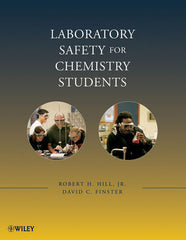Laboratory Safety for Chemistry Students by Robert H. Hill, David Finster
Laboratory Safety for Chemistry Students
Laboratory Safety for Chemistry Students is uniquely designed to accompany students throughout their four-year undergraduate education and beyond, progressively teaching them the skills and knowledge they need to learn their science and stay safe while working in any lab. This new principles-based approach treats lab safety as a distinct, essential discipline of chemistry, enabling you to instill and sustain a culture of safety among students. As students progress through the text, they’ll learn about laboratory and chemical hazards, about routes of exposure, about ways to manage these hazards, and about handling common laboratory emergencies. Most importantly, they’ll learn that it is very possible to safely use hazardous chemicals in the laboratory by applying safety principles that prevent and minimize exposures.
Continuously Reinforces and Builds Safety Knowledge and Safety Culture
Each of the book’s eight chapters is organized into three tiers of sections, with a variety of topics suited to beginning, intermediate, and advanced course levels. This enables your students to gather relevant safety information as they advance in their lab work. In some cases, individual topics are presented more than once, progressively building knowledge with new information that’s appropriate at different levels.
A Better, Easier Way to Teach and Learn Lab Safety
We all know that safety is of the utmost importance; however, instructors continue to struggle with finding ways to incorporate safety into their curricula. Laboratory Safety for Chemistry Students is the ideal solution:
-
Each section can be treated as a pre-lab assignment, enabling you to easily incorporate lab safety into all your lab courses without building in additional teaching time.
-
Sections begin with a preview, a quote, and a brief description of a laboratory incident that illustrates the importance of the topic.
-
References at the end of each section guide your students to the latest print and web resources.
-
Students will also find “Chemical Connections” that illustrate how chemical principles apply to laboratory safety and “Special Topics” that amplify certain sections by exploring additional, relevant safety issues.


















